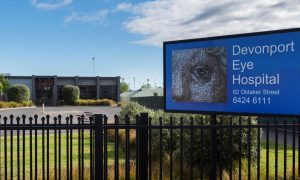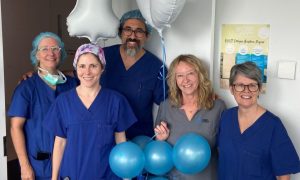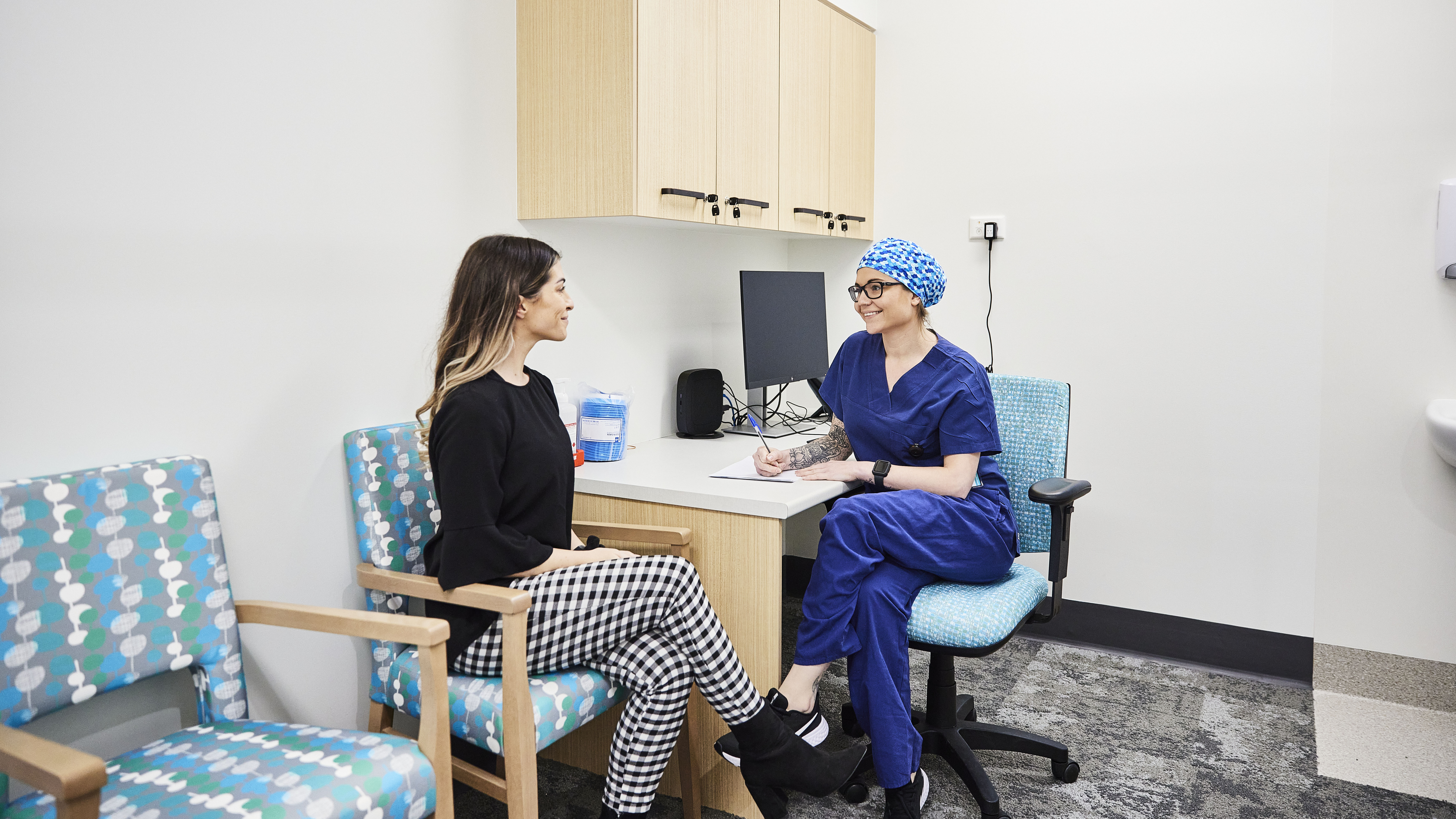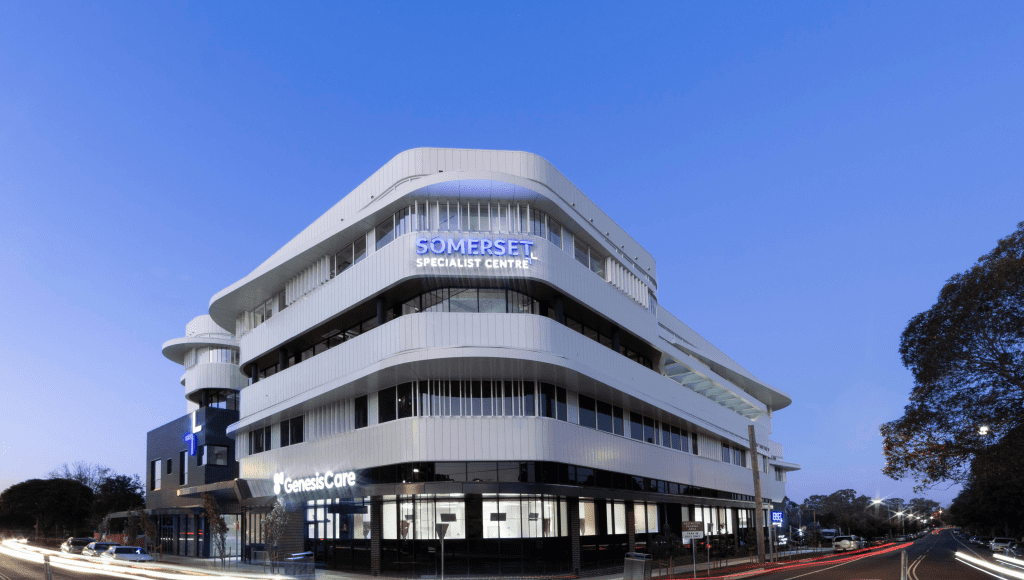Welcome to Somerset Private Hospital
Somerset Private Hospital, specialising in day surgery procedures in Sydney’s western suburbs opened in 2021. The hospital which also provides overnight facilities, has been furnished with the latest technology and equipment to provide specialty services to both adult and paediatric patients. Specialties include Orthopaedics, Plastic & Reconstructive, Gastroenterology, Gynaecology, Ophthalmology, General, IVF, Oral-Maxillofacial and Dental
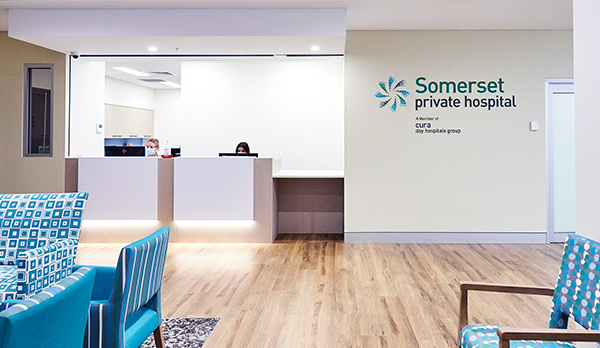
- Patient Information
- Find a Doctor
- Patient Feedback
- Australian Charter of Healthcare Rights
- Patient Safety and Quality
- Governance
- Online admissions
- Our Procedures
Adenoidectomy is a surgical procedure performed to remove the adenoids (a mass of lymphoid tissue located behind the nasal passages).
Cautery of septum, or nasal cauterisation, is a procedure in which the mucous membranes in the nose are cauterised in order to treat nosebleeds (epistaxis).
Functional endoscopic sinus surgery (FESS) is a surgical treatment for some diseases of the nose and paranasal sinuses. It is usually undertaken as surgical treatment for sinusitis and nasal polyposis, including fungal sinusitis.
Rhinoplasty is a surgical procedure which improves the appearance or function of the nose by reshaping the nasal bone and cartilage. It is performed by either an Otolaryngologist – head and neck surgeon, Maxillofacial surgeon, or Plastic surgeon.
Septoplasty is a corrective surgical procedure undertaken to straighten the nasal septum (the partition between the two nasal cavities).
A tonsillectomy is a surgical procedure in which the tonsils are removed from either side of the throat.
A turbinectomy is a procedure to relieve nasal congestion in which some or all of the turbinate bones in the nasal passage are removed.
An anal fissure is a small tear or ulcer in the skin around the opening of the anus. Anal fissures can be treated with several different types of surgery, the most common of which are lateral internal sphincterotomy (a small incision is made in the internal anal sphincter muscle to relax it) or a fissurectomy (in which the surgeon removes all damaged skin around the fissure to enable the wound to heal).
APC is a procedure in which a Gastroenterologist seals irregular or bleeding tissue during a gastroscopy or colonoscopy using ionized argon gas.
A Colonoscopy is an examination of the colon (large intestine) using a long, thin, flexible tube with a camera called a colonoscope.
Flexible sigmoidoscopy is a test that uses a flexible, narrow tube with a light and tiny camera on one end, called a sigmoidoscope , to look inside the rectum and the lower, or sigmoid, colon.
A gastroscopy is an examination of the upper digestive tract (the oesophagus, the stomach and duodenum) using a long, thin, flexible tube with a camera called a gastroscope.
Haemorrhoid banding, or rubber band ligation (RBL) is a relatively non-invasive procedure where elastic bands are applied to the base of the haemorrhoids in order to cut off blood supply and flatten the haemorrhoids.
A haemorrhoidectomy is the surgical removal of haemorrhoids under anaesthetic.
This procedure refers to the infusion of an iron and saline mixture directly into the bloodstream through the use of an IV.
The National Bowel Cancer Screening Program (NBCSP) invites Australians aged over 50 to screen for bowel cancer using a free, simple test at home. Australia has one of the highest rates of bowel cancer in the world. Around one in 23 Australians will develop bowel cancer during their lifetime.
Click here for more information
There is no one recommended screening test for gastric cancer. Screening and diagnostic tests for oesophageal and gastric cancer can be performed via endoscopy. Other screening methods include barium swallow/upper GI x-ray or endoscopic ultrasound.
Oesophageal Dilation is a procedure performed to stretch or widen the oesophagus using weighted dilators.
Polyps are growths on the inside of the colon or gastrointestinal tract and are very common. A polypectomy can be performed during a colonoscopy or gastroscopy procedure.
Sclerotherapy is used as a treatment for Varicose and Spider Veins. It involves the injection of a solution into the vein to intentionally damage the vein causing it to gradually disappear.
Carpal tunnel release is a surgery used to treat carpal tunnel syndrome. There are two types of Carpal Tunnel Release Surgery; Endoscopic and Open.
Endoscopic carpal tunnel release surgery is the use of an endoscope to cut the transverse carpal ligament. The endoscope is usually inserted through a small incision in the palm.
During the open surgery, the surgeon will cut the carpal ligament to relieve pressure on the median nerve, and make more space for the nerve and tendons.
Laparoscopic hernia surgery is a surgical procedure in which a laparoscope is inserted into the abdomen through a small incision to repair the hernia.
Open hernia repair is the procedure performed to repair hernia by pushing the hernia back in place through an abdominal incision.
Laparoscopic Cholecysectomy is the removal of the gallbladder through ‘key hole surgery.’
Surgical removal of lesions is a simple procedure undertaken to remove growths such as lesions, tumours or moles for either medical or cosmetic reasons.
Wedge resection toenail is the surgical treatment for an ingrown toenail.
Dilation and curettage (D&C) is a procedure to remove tissue from inside the uterus. A D&C is usually performed to diagnose and treat certain uterine conditions.
Endometrial Ablation is a procedure that surgically removes the lining of the uterus in order to reduce, or stop menstrual flow.
A hysteroscopy is the procedure in which a thin, lighted tube is used to examine the inside of the uterus and cervix. Hysteroscopy can be used in the diagnosis and treatment of several conditions such as abnormal bleeding, polyps or tumours inside the uterus, and adhesions.
Also known as ‘key-hole’ surgery, a laparoscopy is the procedure in which a laparoscope containing a fibre-optic camera and/or surgical heads is inserted through a small incision in the abdomen. Some of the many problems which can be diagnosed or treated by laparoscopy are infertility, reproductive problems, ectopic pregnancy, urinary disease and liver and pancreas cancer.
LLETZ stands for large loop excision of the transformation zone (of the cervix). In this procedure, the surgeon will remove a small segment of the cervix (the lower part of your womb or uterus) for examination.
IVF was originally developed to treat women with irreparably damaged Fallopian tubes. It allows those stages of conception which usually occur in the tubes – oocyte (egg) collection, fertilization and early embryo development – to be performed in the laboratory i.e. in vitro. It is now widely used to treat most forms of infertility including endometriosis, male infertility, immunological infertility, and idiopathic or unexplained infertility.
Oocyte Pick Up (OPU) is the surgical procedure in the IVF cycle in which the eggs are collected or retrieved.
Sperm aspiration from the testicle (TESA).
A blepharoplasty is a procedure which removes excess or sagging skin from upper and/or lower eyelids. The surgery is usually performed for cosmetic reasons however; it can improve sight in patients whose eyelids are obscuring their vision.
A canthoplasty is a surgical procedure that tightens the area around the eye in order to correct a drooping appearance, and create an upward slant in the outer corner of the eye.
A chalazion is a lump on the eyelid that is usually caused by obstruction of the drainage duct of an oil gland within the upper or lower eyelid. Surgical removal of chalazion may become necessary if vision becomes obscured, or an astigmatism.
Ectropion is a medical condition where the eyelid folds outward. Corrective surgery involves the removal of a small piece of the fold to tighten the muscles in the area.
Excision of lesions is a procedure to remove growths such as lesions, moles and tumours from the skin, sometimes accompanied by frozen sections and followed by sutures or a graft. The most common reason for undertaking this procedure is for the removal of skin cancers such as Basal Cell Carcinoma which is the most common skin cancer on the face.
A wedge excision is a procedure which removes cancers from the edge of the eyelid.
Cataract surgery is the surgical replacement of a cloudy lens with an artificial intraocular lens (IOL) implant to restore vision. The cloudy lens is broken up and removed with an ultrasound probe through a very small incision in the eye, and the artificial lens is inserted.
An ICL procedure involves the insertion of an implantable contact lens in the front chamber of the eye, leaving the natural lens intact. The procedure, undertaken to correct short- or long-sightedness, is often used as an alternative to corrective laser procedures.
A penetrating keratoplasty, or corneal transplant, replaces diseased or scarred corneal tissue with healthy tissue from an organ donor. Corneal transplants can treat a number of conditions such as keratoconus, Fuchs’ dystrophy, corneal infection, corneal dystrophy and corneal injury or trauma.
A pterygium is a growth of blood vessels and fibrous tissues covering the surface of the eye due to over-exposure to sunlight over an extended period of time. A pterygium is treated with a surgical excision and an auto-conjunctival graft.
Squint surgery involves tightening the extraocular eye muscles to change the eye position in order to correct a turned eye.
Glaucoma is characterised by elevated intraocular pressure associated with optic cupping and visual field loss. Trabeculectomy surgery lowers intraocular pressure by forming a new drainage to allow fluid to escape from the eye.
Vitrectomy is a surgery which removes the vitreous gel from the eye to assist in the repair of retinal detachments, macular holes and retinal membrane surgeries.
Dental implants are used to replace damaged or missing teeth. A dental implant procedure is where a screw or metal fixture is implanted into the jaw as the base for a new false tooth.
Dental restoration is a broad term used to encompass any dental procedure, artificial substance or structure with protects the mouth’s ability to eat and chew. The most common form of dental restoration are dental fillings.
Dentoalveolar surgery refers to any procedures on the teeth or jaw bones. This can include dental implants, removal of teeth and removal of cysts of the jaw.
Orthognathic surgery is corrective jaw and face surgery related to face structure and conditions such as sleep apnoea, TMJ disorders or malocclusion. Typically, it is performed when braces cannot treat a particular orthodontic problem.
When wisdom teeth have the potential to cause problems or become impacted, they may be removed surgically. In the procedure, the surgeon makes a small incision and extracts the tooth with forceps.
The temporomandibular joint (TMJ) is the hinge-like joint which joins the jaw to the skull. TMJ dysfunction typically occurs as a result of arthritis or jaw related injury. TMJ disorders are usually managed through arthrocentesis and injections.
A tooth extraction is the removal of a tooth from the dental alveolus (socket) in the alveolar bone.
Anterior cruciate reconstruction (ACL reconstruction) is a common procedure tin which a graft is used to reconstruct the ligament in the knee.
Acromioplasty is an arthoroscopic procedure used to treat impingement or bursitis of the shoulder.
An arthroscopy is a procedure in which an endoscope is inserted in a joint through a small excision in order to diagnose and treat a number of conditions. An arthroscopy can be performed on a knee, shoulder, wrist or ankle.
Biceps reimplantation is the surgical treatment of bicep tendonitis of the shoulder. The surgeon cuts the tendon and reattachs it to the humerus bone therefore reducing pressure from the shoulder.
Endoscopic carpal tunnel release surgery is the use of an endoscope to cut the transverse carpal ligament. The endoscope is usually inserted through a small incision in the palm.
Carpal tunnel release is a surgery used to treat carpal tunnel syndrome. During the surgery, the surgeon will cut the carpal ligament to relieve pressure on the median nerve, and make more space for the nerve and tendons.
Dupuytren’s contracture is the development of a fibrous connection between the finger tendons and the skin of the palm resulting in a forward curvature or ‘clawing’ of one or more fingers. Treatment for Dupuytren’s contracture includes needling, injections and surgical procedures to sever the tissue causing the contracture.
A joint replacement (or arthroplasty) is usually performed to ease arthritis related symptoms, and will most likely involve a surgeon removing the affected joint and replacing it with an artificial implant.
Labral reconstruction is a procedure in which the native labrum is reconstructed using a graft.
Lateral release surgery is a procedure performed on the knee to realign the patella (kneecap). It is usually performed as an arthroscopic procedure.
Meniscal repair is a surgical procedure performed to repair torn knee cartilage.
Metatarsophalangeal (MTP) Joint Fusion is a surgical procedure in which the MTP Joint (big joint of the big toe) are fused together.
An open reduction and internal fixation (ORIF) is a procedure in which the fracture is reduced and fixated using wires, plates or screws.
Rotator cuff repair procedures are most commonly performed by arthroscopic surgery, however in some cases open shoulder surgery may be necessary. The procedure involves removing any loose fragments from the area, and then surgically repairing the tendon.
Subacromial decompression is a procedure used to treat shoulder impingement, usually by reshaping a part of the shoulder blade.
Trigger Finger, also known as stenosing tenosynovitis or flexor tendonitis, is a condition where one of the fingers or thumb of the hand is caught in a bent position. Surgery may be undertaken to release the tight portion of the flexor tendon sheath.
Commonly referred to as a ‘tummy-tuck’, an abdominoplasty is a cosmetic or reconstructive surgery to remove excess skin and fat from the abdomen, and to tighten the stomach muscles.
Breast augmentation is the surgical increase of the size of woman’s breasts, usually through the use of breast implants.
A breast lift, or mastopexy, raises and firms the breasts by removing and tightening the surrounding skin.
Breast reduction surgery also known as reduction mammoplasty is a procedure to reduce the size of large breasts through the removal of excess fat, tissue and skin from the breasts.
The forehead lift or browlift is performed to correct sagging eyebrows or improve the lines of a person’s forehead.
An excision of melanoma procedure is the surgical removal of melanoma (a form of skin cancer).
Facelift, also known as meloplasty or rhytidectomy, involves surgical procedures that tightens and removes drooping skin.
Gynaecomastia surgery aims to remove the excess breast tissue, fat and skin from the male chest. Surgery usually consists of a combination of liposuction followed by glandular excision.
Labiaplasty surgery is a procedure which reduces and reshapes excess labia minora tissue of the vagina.
A lipectomy refers to any surgical procedure carried out to remove excess body fat. The most common of which is liposuction (a surgical procedure which suctions out excess fat).
Otoplasty, also known as ear correction surgery or ‘ear pinning’, is performed to move prominent or protruding ears closer to the head. It is done using permanent sutures to hold the ears in place.
Sentinel node biopsy is usually performed to identify whether cancer such as breast cancer or melanoma has spread to the lymphatic system. The procedure involves injecting a tracer material to help locate the nodes, and then removing the nodes for analysis.
Contact Details
Opening Hours: 7:00am to 5:00pm, Monday to Friday. Our friendly personnel are always ready to assist with your enquiries.
Tel: (02) 4723 0500
Contact Person: Marc Monsell, CEO/Director of Nursing [email protected]
Address: Level 1, 38 Somerset Street Kingswood NSW 2747
- Follow Somerset Private Hospital on social

